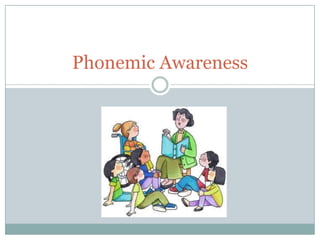Phonemic Awareness
•Transferir como PPTX, PDF•
2 gostaram•6,169 visualizações
Denunciar
Compartilhar
Denunciar
Compartilhar

Recomendados
Recomendados
Mais conteúdo relacionado
Mais procurados
Mais procurados (20)
What's the difference between letter names and letter sounds

What's the difference between letter names and letter sounds
Destaque (6)
Semelhante a Phonemic Awareness
The Speech Sound Pics Approach has been created by the Reading Whisperer for Australian schools. This presentation shows the research on which SSP is based, as well as an overview regarding HOW to teach any child to read and spell before year 2.
www.facebook.com/readaustraliaSSP Overview for School Leaders and Curriculum Planners, with Research Focus

SSP Overview for School Leaders and Curriculum Planners, with Research FocusRead Australia (Wiring Brains Education)
Semelhante a Phonemic Awareness (20)
SSP Overview for School Leaders and Curriculum Planners, with Research Focus

SSP Overview for School Leaders and Curriculum Planners, with Research Focus
Session-3-Getting-Started-in-Beginning-Reading-LILETTE-DELA-CRUZ.pptx

Session-3-Getting-Started-in-Beginning-Reading-LILETTE-DELA-CRUZ.pptx
What is Jolly Phonics & 5 skills of Jolly Phonics.pptx

What is Jolly Phonics & 5 skills of Jolly Phonics.pptx
Why call them Speech Sound Pics ? The SSP Approach

Why call them Speech Sound Pics ? The SSP Approach
Updated :Para professional pd reading presentation

Updated :Para professional pd reading presentation
ASL Nursery Rhymes Exploring A Support For Early Language And Emergent Liter...

ASL Nursery Rhymes Exploring A Support For Early Language And Emergent Liter...
Mais de TahaneeH
Mais de TahaneeH (6)
Phonemic Awareness
- 2. Phonemic awareness refers to the ability to segment and manipulate the sounds of oral language. It is not the same as phonics, which involves knowing how written letters relate to spoken sounds. Research has shown that a child’s awareness of the sounds of spoken words is a strong predictor of his or her later success in learning to read -International Reading Association
- 3. 7 Dimensions of Phonemic Awareness 1. The ability to hear syllables within a word 2. The ability to to hear initial sounds or recognize alliteration ( Sally Sells Seashells by the sea shore) 3. The ability to distinguish rime and rhyme(Rime: hat cat sat; Rhyme: great late bait) 4. The ability to distinguish oddity (man money cat) 5. The ability to blend sounds orally to make a word (/a/ +/t/=at) 6. The ability to segment words orally (at=/a/+/t/) 7. The ability to manipulate sounds orally to create new words (Plug-/g/=Plu; Plu+/m/=Plum) -Devries
- 4. Scaffolding By choosing books with alliteration, assonance, rhyme, repe tition, onomatopoeia, and nonsense words educators help new readers, “develop an ear for the sounds within words” (Devries 2004). Read aloud (model good reading, use expression) Use Gestures (clap, tap, snap syllable and rhyme) Vary reading materials (tongue twisters, nursery rhymes, poems, songs and music) Use “concrete cues”-manipulatives (wicklund 2004)
- 5. Activities Jump Rope Jingles Chopping game Match Game
- 6. ISEL Illinois Snapshot of Early Literacy Assesses phonemic awareness, letter recognition, and knowledge of letter sounds Given three times a year On Target vs On Watch
- 7. Literature to support Phonemic Awareness
- 8. References DeVries, B. A. (2011). Phonemic Awareness. Literacy assessment and intervention for the elementary classroom (pp. 76-100). Scottsdale, Ariz.: Holcomb Hathaway Publishers. International Reading Association. (2012). Phonemic Awareness . Phonemic Awareness and the Teaching of Reading. Retrieved April 10, 2012, fromhttp://reading.org/General/AboutIRA/PositionState ments/PhonemicAwarenessPosition.aspx Wicklund, B. (2004). Using scaffolding to teach phonological/phonemic awareness skills to english language learners Hamline University | Saint Paul, Minnesota. Hamline University | Saint Paul, Minnesota. Retrieved April 9, 2012, from www.hamline.edu/WorkArea/linkit.aspx? LinkIdentifier=id...
